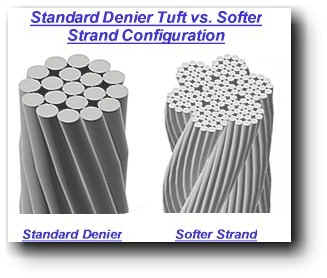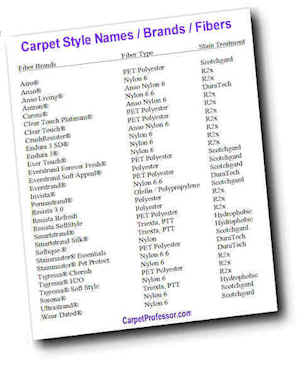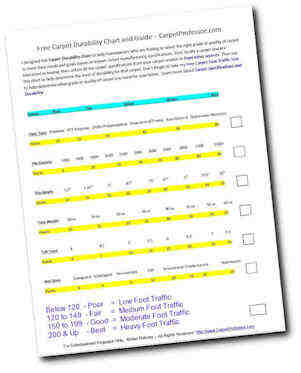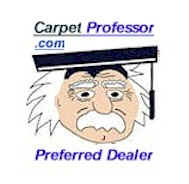How To Choose New Flooring Like A Pro!
Carpet | Vinyl Tile & Plank | Hardwood | Local Stores
(Free Information by Consumer Advocate - No Flooring Sales)
Carpet Fibers - Soft Nylon, BCF and Denier
When choosing new Carpet, the fiber your carpet is made from will determine how long your new carpet lasts, how soft it feels, what colors are available, how easily it cleans and how much it costs. Choosing the right fiber is one of the most critical factors when selecting new carpet.
5 Main Carpet Fibers:
-
Nylon
-
Olefin / Polypropylene
-
PET Polyester / Polyester
-
Sorona / Triexta / PTT
-
Wool
No fiber is considered perfect to make carpet and no two fibers are the same. They each have their good and not-so-good qualities. Every fiber has different manufacturing methods, costs, manufacturing processes and properties. This is why choosing new carpet can be so confusing.
Nylon is the most durable and the most resilient fiber and therefore does not mat down so easily. It is the best choice for moderate to heavy foot-traffic applications. There are several other fiber types to choose from, and each have their good and bad qualities. Softer Nylon carpet styles are designed for homeowners who want the durability of a nylon carpet with the softness of a carpet made of wool.
Softer Does Not Mean Better
Everyone wants soft carpet, but making the strand thinner may make the fiber feel softer, but it may also make the fiber less resilient and less durable too. However, the price you pay will certainly be higher! Softer does mean more expensive! If you have heavy foot traffic in your home, you may want to avoid selecting carpet made with a "soft" nylon fiber.
Carpet Fiber & Durability Guide
Nylon Fibers (standard denier)
Nylon is a generic name or designation for a family of synthetic polymers first produced in 1935 by the DuPont Company. Nylon is a synthetic fiber that outperforms all other fibers. It wears exceptionally well, is very resilient, resists abrasion, resists stains and is easy to clean.
The Definition of Resilient: Being able to recoil or spring back into shape after bending, stretching, or being compressed.
Nylon is the most resilient fiber. Every time you take a step on your carpet, the surface fibers are bent, compressed and stretched. Nylon bounces back. This is why carpet made of Nylon keep looking like-new longer than any other fiber. Nylon is the most expensive synthetic fiber. I would consider choosing a Nylon carpet if you have a lot of foot traffic and longevity was my biggest concern.
Nylon's Good Qualities:
-
Most resilient of all fibers (doesn’t mat down easily)
-
Maintains a new appearance longer
-
Resists stains
-
Easy to clean
-
Super durable
-
Can be color-dyed
Nylon's Not-So-Good Qualities:
-
Color Fades in direct sunlight
-
More costly than other synthetic fibers
-
Colors are not as bright or vivid as Polyester, PET or Sorona, PTT
-
Not as Stain Resistant as Polyester or Sorona
Nylon 6.0 vs. Nylon 6,6
There are two types of Nylon fiber, one is referred to as Type 6 made by Anso®, and Type 6,6 made by Antron®. I prefer Antron's Nylon 6,6 and think it is a better fiber, but how much better? Not so much that I would pay a lot more to get it, however if all specifications and price were about equal then I would certainly opt for Nylon 6,6.
New Names for the Same Old Fibers?
All fibers can be modified in many ways to make them look or feel different. Some fibers are “bulked up” to make them look and feel thicker. Some fiber strands are made thinner so they feel softer. These changes are common in the fiber industry and have been so for decades. This is nothing new. Even if they change the name or say it is new and improved, the main characteristics of the original fiber still hold true. Check out my Branded Carpet Style / Fiber ID Chart to see which fiber these popular carpet style names are made from.
(Click on the chart to view or print.)
Branded Carpet Fiber Chart.pdf
Carpet Fiber and Durability Guide
Stainmaster® Brand Name Update
The Stainmaster brand name was recently purchased by Lowe's. Yes, the home improvement store. From now on, the only way to purchase carpet with the Stainmaster® brand name is to buy it at Lowe's or one of their authorized outlets. However, the same nylon fiber known as type 6,6 is still available in many popular carpet styles at local carpet retailers under different brand names. They may own the name but they don't own the fiber.
Homeowners can still buy carpet made from Antron's nylon 6,6 at most local carpet stores and still enjoy all the same benefits without having to shop at Lowe's or pay extra to get the Stainmaster® brand. This is good news for homeowners. You don't have to shop for nylon 6,6 carpet at Lowe's just because they own the Stainmaster® brand name.
Q. Do "Soft Nylons" hold up as well as a regular (standard Denier) Nylon fibers?
This is an excellent question. From my experience, I have found that "soft nylon" fibers are not quite as resilient or as durable as a standard (non-soft) denier nylon fiber.
The higher the denier, the heavier the filament. The way they make a standard nylon fiber softer is to make the strand thinner. By doing so, I believe that some of the resiliency is lost. This thinner strand creates a carpet that is softer to the touch but may be more susceptible to matting and crushing. Don't take this the wrong way, I'm not steering you away from buying a soft nylon, but if you want to have the absolute most durable and most resilient nylon for the money, I suggest you buy a carpet made with a standard denier nylon fiber.
What is Fiber Denier?
Denier is the diameter of a single extruded fiber strand. Fiber denier is easily understood for those who have gone fishing using a nylon filament fishing line. The thicker the line is, the stronger it is. When fishing for Trout, some people use a 4-pound test line. For bigger fish like Steelhead or Salmon, a thicker 6, 8 or 10-pound nylon test line may be used.
 Some carpet fibers are
purposely manufactured thinner to make a carpet that
feels softer to the touch, but in doing so some of the fiber strength, durability or
resiliency may be sacrificed.
Some carpet fibers are
purposely manufactured thinner to make a carpet that
feels softer to the touch, but in doing so some of the fiber strength, durability or
resiliency may be sacrificed.
Carpet made with fibers of a standard gauge denier will be more durable and more resilient than carpet made from a thinner strand as is commonly used in today's branded "Soft Nylon" carpet styles.
What Does "Branded" Mean?
A branded product is one made by a well-advertised or well-known maker with label or name attached to it. When it comes to carpet, a specific type of product can be branded and advertised and marketed to attract consumers. The cost of "branded" products are more costly because of their characteristics and marketing. Soft Nylon carpet styles are designed for homeowners who want the durability of a nylon carpet with the softness of carpets made from wool.
Sorona® / PTT / Triexta - (aka Smartstrand® by Mohawk™)
If you want a carpet that is durable, soft and resist stains, Sorona® may be the fiber you are looking for. Sorona has permanent stain resistance that is engineered into the fiber and will never wear or wash off. But remember, no carpet is completely stain proof.
Sorona, also known as Triexta or PTT was developed by DuPont™. It is a polymer derived from corn. It is said to have the best anti-stain properties and cleans easier than any other fiber. They also say it is very durable.
Sorona is clearly more durable than P.E.T. or Polyester, but is it as durable as Nylon? I do believe that Sorona resists stains better than Nylon, but the high durability and resiliency of Nylon is well documented. Either way, Sorona may be the fiber you need for your home and stain resistance is your main concern. Bear in mind, I would not suggest this fiber for those with heavy foot- traffic applications, especially if you expect your new carpet to last more than 10 years.
Mohawk Industries, a well-known carpet manufacturer, has a line of carpet styles made with the Sorona / Triexta fiber and they have branded it Smartstrand®.
Sorona & Smartstrand Carpet Fibers
Q. Sorona has been around for many years now, do you think it's as good as they claim? What I have come to believe at this point is that Sorona is a durable fiber, it also cleans easily and resists stains a little better than a Nylon. Sorona is not a miracle fiber, it has limitations like any other fiber. You must select a grade that is designed to tolerate your level of foot traffic.
This is true with any carpet no matter what fiber it is
made of. This means having
enough face-weight, pile density and adequate tuft-twist to meet or exceed your
needs, goals and lifestyle. It is also important to keep the pile height below
3/4 of an inch or risk potential matting and crushing of the pile in medium to
heavy traffic areas. (stairs and hallways)
Knowing what grade of carpet to buy is the key and many folks end up buying a
carpet that is incapable of tolerating their level of foot traffic. This always
ends in frustration and makes for an unhappy customer. That's why I created a
free and simple Carpet Foot
Traffic Test so folks would have some idea about where they
stand and what grade of carpet to
consider buying.
This is my take so far and I still firmly believe that Nylon is more durable and has
better resiliency than Sorona, but Sorona does seem to resist
stains a little better than a nylon to some degree, how much is debatable.
Carpet Fiber & Durability Guide
The Polyester or P.E.T. Polyester Fibers
Polyester is one of the least expensive synthetic fibers to manufacture. A thick polyester carpet may feel nice and soft, but it is not a resilient fiber, and it does not a make a long-lasting carpet. Polyester carpets tend to mat down in a hurry, and that has always been the problem with carpets made from this fiber.
When you walk on a carpet, with each footstep you crush, bend and compress the fibers. Over time the fibers begin to weaken and the tufts fall over and stay that way. Once polyester fibers are bend over, they will fail to spring back to their original position. This is why new carpet warranties for carpets made of polyester do not cover matting or crushing of the pile.
Don’t be mislead by salespeople who recommend carpets made with polyester. Don't agree to buy carpet made from polyester unless you know exactly what to expect and not pay too much for it. Personally, In a medium traffic application, I wouldn't expect to get a life span of more than 5 years on any polyester carpet, regardless of its tuft twist, density rating or warranty claims. I might consider choosing a carpet made of polyester if I had low foot-traffic and want to spend as little as possible.
Low Cost Carpet Deals
To spend the least amount of money for new carpet, choosing an inexpensive polyester carpet may be a viable solution for you. For example: In applications where minimum carpet specifications will suffice; in areas where damage from pet urine is an ongoing problem; or if you need to replace the carpet on a regular basis for any reason. If the size of your rooms are small and the color or style doesn't matter that much, you may be able to find low-cost carpet deals with Carpet Remnants.
Carpet Fiber Blends
Some carpets are made with a blend of Polyester and Nylon fibers. Usually a small amount of nylon is added to the mix. They do this to try to make a polyester carpet a little bit more resilient and slightly more durable.
While this may have a benefit to consumers in some situations, I personally do not believe it makes a worthwhile or more valuable product. It's like putting a Mercedes hood ornament on a Ford Fiesta. It doesn't make much sense to me. But carpet makers have long tried to come up with a way to make carpet made from Polyester more durable because it is so cheap to manufacture.
Olefin Carpet Fibers (aka Polypropylene)
Olefin is a very strong synthetic fiber. It is often used to make Berber carpets, commercial carpets and outdoor grass carpets. Olefin wears well and has good stain resistance when anti-stain treatment is applied. Olefin also has good anti-static properties.
However, Olefin is not easy to keep clean and tends to look dingy when soiled. It has poor resiliency so smaller looped Berber styles wear better than do larger looped styles. Read My Article: Lifestyle Often Dictates Best Carpet Choice for those with kids or pets.
Commercial looped carpets wear very well, as the loops tend to be very small which leaves little room for the loops to become matted or crushed. Wheelchairs roll easily over commercial level loop Olefin carpets that are glued-down without padding and may be a good choice for handicapped areas, hospitals and retirement home applications.
When comparing Berber carpets made of Olefin smaller loops, in a tighter weave will yield a longer wearing carpet. About Berber Carpet - How to Choose Berber Carpet Wisely
Wool and Wool Blend Carpet Fibers
Wool is a natural fiber and should not be compared to a synthetic fiber. Some carpets are offered with a blend of nylon and wool in varying amounts. Usually I see 20% nylon and 80% wool. This gives wool some of the characteristics of nylon like increased resiliency and durability as well as lower cost. This can be a very good blend to consider having in your home. Learn about Carpet Comparison
Wool carpets are considered the most elite of all fibers and are the most expensive of all fibers. Wool is a natural fiber and is very soft. It has excellent insulating qualities and is naturally fire-resistant. However, wool carpets must be professionally cleaned using specialized carpet cleaning methods and is more expensive to maintain and install than synthetic carpet fiber styles.
Comparing wool carpets based on price and quality can be more difficult because well-known brand names can increase the cost dramatically and the quality level may be more difficult to determine. Soft Nylon carpet styles are designed for homeowners who want the durability of a nylon carpet with the softness similar to wool carpet, but less costly. If you can afford wool carpets it would be an excellent choice for most homes. However, children and pets can be very hard on any carpet so careful consideration should be taken if you have small children or pets prone to spills and accidents.
What Does B.C.F. Mean? (Bulked Continuous Filament)
I am confused about carpet specifications. I see these initials on the back of some carpet samples but not others? What does BCF mean? BCF stands for Bulked Continuous Filament. You might want to buy a carpet made from a Continuous Filament fiber if you hate vacuuming. Why do some carpets shed and fuzz?
The word "Bulked" refers to a process where the manufacturer makes the strand of fiber beefed up, or bulked to create a fatter and more beefy feel. Think of it like using a volumizer on your hair. It makes it feel thicker and fuller. The "CF" or Continuous Filament, means the strand is formed in one long strand. When they make carpet from a CF fiber is virtually eliminates the shedding and fuzzing that you experience with carpet made from a Staple Fiber.
What is a Carpet Staple Fiber?
A "staple fiber" is short lengths of fiber strand, usually 3 to 10 inches long, that are spun (twisted) together to form a tuft. When carpet is made from a staple fiber, the carpet will shed and fuzz for up to a year after installation.
Every time you vacuum, your vacuum bag will fill up quickly with loose carpet fuzz. This is to be expected, but if you select a carpet made from a continuous strand, (aka BCF) then you will not have the shedding or fuzzing issues that you encounter with a carpet made from staple fibers. Learn more: Carpet Shedding and Fuzzing
What is a Continuous Filament Fiber? (BCF, CF, or CFN?)
Continuous filament is a synthetic polymer that is melted and then extruded through a nozzle in one long never-ending strand. They do the same type of procedure to make spaghetti.
If the Carpet Sample does not indicate that the fiber is made from a Bulked Continuous Filament strand (BCF), then you should assume that the carpet pile is made from staple fibers and therefore will shed and fuzz for a period of time after installation. The amount and duration of shedding and fuzzing is determined by the quality of the carpet and the length of the staple fibers used in construction. There is no way to know for sure how long a carpet will shed and fuzz in your home.
"Unless you like vacuuming three times a day, and filling up your vacuum bag with loose fuzz, then I suggest you buy a carpet made from a Continuous Filament Fiber."
Some Carpet Samples might use the abbreviation of CF, for Continuous Filament, or CFN for Continuous Filament Nylon. If a carpet sample is simply marked "100% Nylon" you should assume it is NOT a "Continuous Filament" fiber. Learn more about Carpet Specifications
Carpet Durability Chart
Print and use my free Carpet Durability Chart to help determine if the carpet you are considering is durable enough for your needs and goals. You just need to know the carpet specifications to use this chart effectively.
To Print or View: Carpet Durability Chart
Learn More:







